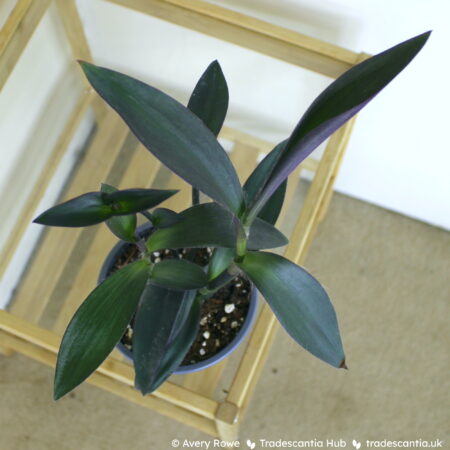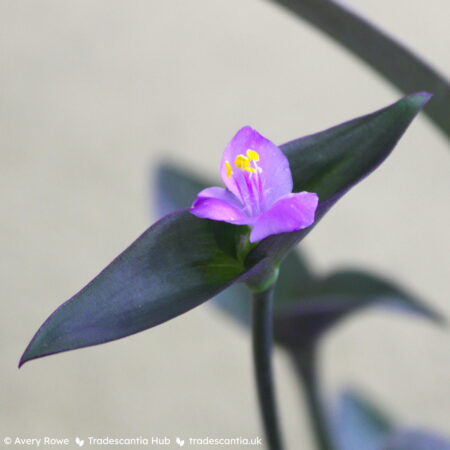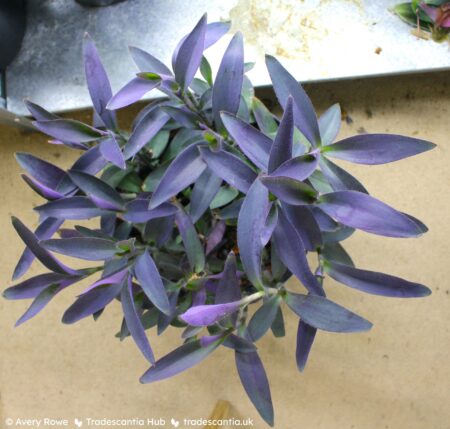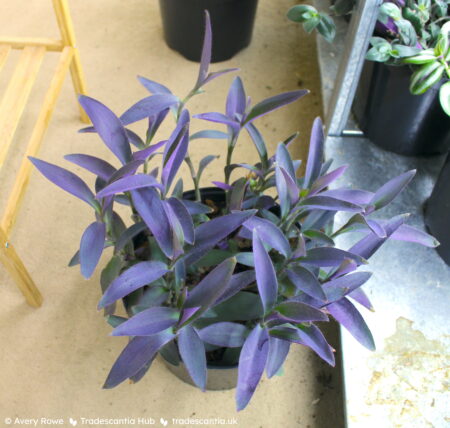Details
| Full name | Tradescantia pallida ‘Purpurea’. |
| Name status | Accepted, the valid name for a unique cultivar. Established with a description and drawing by Boom (1955). Because it was published before 1959, the reused Latin name can be accepted (Brickell et al., 2016, Arts. 21.11., 21.7). Also known as:
Not to be confused with:
|
| Origins | Collected from the wild by C. A. Purpus at the beginning of the 20th century, from Central or North America (Boom, 1955). |
| Classification | Originally published as Setcreasea purpurea. This is now considered a botanical synonym for the species Tradescantia pallida (POWO, 2022), so the plant is treated as a cultivar with the same name (Brickell et al., 2016, Art. 21.5). |
| Legal protection | None. |
| Availability | Mass-produced and widely available. |
Description
Preserved as a herbarium specimen (“Tradescantia pallida”, 1982).
Described with reference to the RHS Colour Chart (6th Edition: 2019 reprint).
The entire plant can vary its appearance dramatically in different conditions – changing in growth habit, leaf shape, size, hairiness, and colour. It’s impossible to cover every possible variation, but this general summary describes a healthy plant grown in typical indoor conditions (moderate light) and outdoors in full sun (intense light).
| Species | Tradescantia pallida. |
| Growth habit | Growth is initially fairly upright, but long stems will eventually start to trail. In intense light it will stay compact and upright for longer, whereas in moderate light it will trail more easily. |
| Foliage | Stems are 4-7mm wde, with internodes 1-6cm long – usually shorter at the base and elongating towards the top of flowering stalks. They are smooth and hairless, and range from dark greyish green (N189A) to dark purplish grey (N186A). Leaves are long ovals, 8-13cm long and 2-4cm wide, with fluffy hairs scattered over both surfaces. In moderate light, the upper surfaces are dark greyish green (N189A). In intense light they become dark purplish grey (N186A). Leaf undersides are dark purplish grey (N187A) to dark purple (79B). Sheaths are greyish yellow green (191A). |
| Flowers | About 20mm across. Petals are slightly rounded and light purple (76A). |
| Comparisons | Compared to Tradescantia pallida ‘Purple Pixie’, this cultivar has longer stems, narrower leaves, and more greyish-green colours. |
References
Boom, B. K. (1955). Notes on Cultivated Plants. Acta Botanica Neerlandica, 4(2), 167-171. doi:10.1111/j.1438-8677.1955.tb00325.x. Open access link.
Tradescantia pallida. (1982). [Herbarium specimen, barcode WSY0064428]. RHS Wisley Herbarium.
Brickell, C. D., Alexander, C., Cubey, J. J., David, J. C., Hoffman, M. H. A., Leslie, A. C., Malécot, V., Jin, X. (2016). International Code of Nomenclature for Cultivated Plants. PDF link.
POWO. (2022). Setcreasea pallida. Plants of the World Online. Link.




